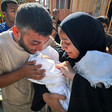Rights and Accountability 27 November 2017
But the closure of Gaza is an Israeli policy that dates back to the beginning of the occupation in 1967, as a new documentary by Al Mezan, a Gaza-based Palestinian human rights group, makes clear.
The highly informative 40-minute film, titled Closure, can be watched at the top of this page. It can be understood by both English and Arabic-language audiences.
Israel first imposed closure on Gaza and the West Bank in 1967, declaring them closed military zones and prohibiting exit and entry of Palestinians from the territories. Residents who happened to be outside the territories at the time, whether for business, study or otherwise, were prevented from returning home.
Israel drafted new military orders as it colonized the West Bank and Gaza Strip, imposing a permit regime that would lead to a further 120,000 Palestinians losing their residency rights in the first two decades of the occupation.
They would join in exile the hundreds of thousands of Palestinians dispossessed during the conquest of Palestine and the declaration of the state of Israel in 1948.
(The Israeli journalist Amira Hass points out in the film that after the 1967 occupation, Palestinians were living under a single rule – albeit with different configurations – for the first time since 1948, when Israel was declared on 78 percent of the Palestinian homeland.)
“This project, at its core, targets the existence of the Palestinian people in their land,” says Shawan Jabarin, director of Al-Haq, a Palestinian rights group based in the West Bank.
Movement became a privilege, not a right
Closure on Gaza was lifted in 1972 and the military permitted Palestinians there to access the West Bank and Israel as Palestinian workers in Gaza were viewed as a source of cheap labor that would benefit Israel’s economy.
A fence was built around Gaza in 1974 and Erez checkpoint was installed so Israel could control Palestinian movement from Gaza to the West Bank and Israel.
“People moved at will day and night,” says Salem Abu Haddaf, a Gaza farmer.
Abu Haddaf describes West Bankers traveling to Gaza to buy fish and returning home the same day.
Farmers were able to sell their produce in the West Bank and Israel, without being held up at checkpoints.
Palestinians from Gaza married spouses in Jerusalem, traveling back and forth to visit family, and vice versa.
There was a time that 40 percent of the student body at Birzeit University, located in the West Bank, were from Gaza – today not one student from Gaza is enrolled at the university.
It was a reality that is vividly remembered by an older generation, but unthinkable for any Palestinian who was born after the signing of the Oslo accords by Israel and the Palestine Liberation Organization in the 1990s.
After Oslo, Israel began tightening Palestinians’ movement, which once again “became a privilege, not a right,” Al Mezan director Issam Younis states in the film.
Fragmentation of society, then the land
Journalist Amira Hass describes Israel’s strategy thus: “With this fragmentation of society, it is easier then to proceed with the fragmentation of the territory, of the land.”
And so farmers encountered greater restrictions on the exports of their produce, and fishermen limitations on their access to Gaza’s coastal waters.
Palestinians living in Gaza were increasingly denied permits to visit family in the West Bank, and vice versa, until those permits became all but impossible to come by.
The movement of both people and goods from Gaza was viewed by Israel as an exception, not a norm, necessitated only by extenuating humanitarian circumstances.
Hass rejects the notion that the Israeli blockade imposed in 2007 was solely a reaction to Hamas taking control of the Gaza Strip following its legislative election victory one year prior.
“We have to see it as a gradual policy [starting] from 1991,” she explains, criticizing Hamas and Fatah, the two main Palestinian political factions, for “working to deepen the rift and consolidate the idea that Gaza is a separate entity.”
Al-Haq’s Jabarin also directs criticism at elements of the Palestinian leadership.
“After 50 years, some of our people are assisting the occupation, acting as tools to enable its policies and collaborate with them,” he says, alluding to the Palestinian Authority led by Mahmoud Abbas. “It’s the lowest point one can reach.”
“Brink of an abyss”
The film makes clear that the Palestinian people are at a critical stage in their struggle for survival.
Entire families were wiped out during Israel’s wholesale war on Gaza in 2014, with no accountability for victims in sight.
Gaza farmer Salem Abu Haddaf finds that after his agricultural land was spoiled during the military’s ground invasion in 2014, it became infertile.
Majed Bakr, a fisherman, says he told his son that because of Israel’s strangling of his trade and constant harassment by its navy, “I hate the sea and I don’t want to sail anymore.”
He encouraged his children to persevere with the family’s livelihood, only to find his son Muhammad’s lifeless body in an Israeli hospital after he was fired on and arrested while at sea.
Jabarin describes Israel’s goal as “the systematic, slow erasure of our existence, conducted through campaigns targeting Palestinian people, our society, our future and development, our social welfare.”
He adds: “What is happening is destroying an entire generation, stripping away their desire to work, produce and prosper.”
Al Mezan’s Issam Younis sees the situation as no less grave than his colleague Jabarin.
“Gaza and the West Bank [are] on the brink of an abyss,” says Younis. “Unless there is a change to the status quo, one can expect the worst.”





